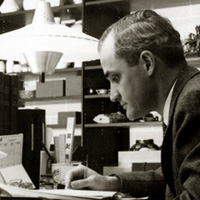This exhibition explores the socio-political context for the American collecting of Asian Art in the post–World War II period with a particular focus on the collecting practice of John D. Rockefeller 3rd (1906–1978) and his wife Blanchette Hooker Rockefeller (1909–1992).
John D. Rockefeller 3rd, founder of Asia Society and son of collectors John D. Rockefeller, Jr. and Abby Aldrich Rockefeller, played an instrumental role in fostering cultural understanding and cooperation between Asia and America during this period. After the war, he became involved in the international politics of Asia with his work for the 1951 peace mission to Japan. Two years later he established the Council on Economic and Cultural Affairs, Inc. (CECA), an organization created to stimulate and support international economic and related activities with a focus on Asia. His work in Asia led to extensive travels and the formation of strong friendships throughout the region. John D. Rockefeller 3rd and Blanchette Hooker Rockefeller hoped that through their support of Asian art and culture they would have a direct impact on international relations, ultimately improving understanding between the citizens of the Unites States and Asia.
From 1963 to 1978, the Rockefellers worked with Sherman E. Lee (1918–2008) as an advisor to their collection. The relationship between the Rockefellers and Lee was an extraordinary example of the connections between art collecting and American and Asian international relations. This exhibition is as much a tribute to the Rockefellers as champions of cultural understanding as it is to Lee’s influence as a curator, art historian, and collections builder.
Adriana Proser
with Jacqueline Ganem and Daisy Yiyou Wang
Morgan Stanley is the lead sponsor of this exhibition. Part of the Morgan Stanley Innovators Series.

The early decades of the twentieth century saw a rise in American interest in Asian art. With contributions from pioneering art experts such as Ernst F. Fenollosa (1853-1908), Ananda K. Coomaraswamy (1877-1947), and Charles L. Freer (1854-1919), important American collections were formed by both institutions and private collectors.